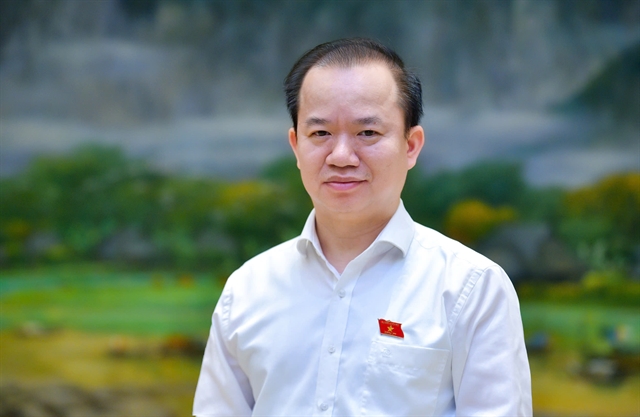 Opinion
Opinion

 |
| Standing Member of the National Assembly’s Committee for Culture and Education Bùi Hoài Sơn. — Photo quochoi.vn |
The draft Revised Law on Value-Added Tax (VAT) is scheduled for a vote in the National Assembly on November 26, proposing an increase the VAT rate on goods and services in the cultural sector from 5 to 10 per cent.
This change has raised concerns among lawmakers, who are urging the Government to reconsider. Bùi Hoài Sơn, a Standing Member of the National Assembly’s Committee for Culture and Education and an NA deputy representing Hà Nội, talked with the press about the tax rise.
What is your perspective on this change and how it might affect efforts to preserve and promote cultural values?
I believe that the VAT hike would severely hinder efforts to preserve and promote cultural values. Higher taxes will create financial challenges for cultural organisations, businesses and artists, making cultural products like books and music more costly and less accessible, particularly for low-income communities.
As cultural products become less affordable, fewer people will participate in cultural activities, leading to the fading of traditional values. This trend also weakens intergenerational ties and diminishes cultural expressions, such as festivals and folk arts, which are essential parts of national identity.
Additionally, the VAT hike would hinder cultural preservation projects, which often require significant funding. With higher tax burdens, securing sponsorships and partnerships becomes harder, risking the neglect of heritage sites that embody the nation’s rich legacy.
We need favourable tax policies that support cultural development rather than create barriers, ensuring that traditional values remain vibrant, rooted in everyday life, and a foundation for sustainable growth.
Reducing or exempting VAT for cultural products could lower costs and broaden access, allowing books, films and exhibitions to inspire and enrich lives instead of being luxuries.
By promoting public-private partnerships through favourable tax policies, we can attract private investment in culture. A collaborative cultural environment will generate meaningful products, ensuring a vibrant cultural foundation and inspiring future generations with a shared sense of pride and identity.
Given these concerns, what solutions might replace the tax increase while still supporting the budget and fostering cultural growth?
To promote cultural development without raising taxes, we need innovative and flexible solutions that support budget needs without placing a burden on cultural businesses and individuals. One key approach is to encourage private investment in culture through tax incentives for donations, fostering financial resources and stronger community ties that fuel cultural growth.
Another effective strategy is establishing cultural funds. These could be set up by the Government and NGOs, allowing donors to support heritage conservation, cultural events and arts projects. This creates stable funding while encouraging community involvement in cultural preservation.
Cultural tourism is also a valuable avenue. By launching cultural tourism programmes, we can attract local and international visitors, generating revenue for the budget while supporting heritage conservation.
Public-private partnerships can also be powerful, enabling joint sponsorships for festivals and major cultural events. This model reduces the government’s financial burden while giving businesses a chance to strengthen their brands through cultural support.
Finally, increasing public awareness and education about culture is essential. When people understand the value of culture, they are more likely to contribute and engage, forming a strong social foundation for cultural development.
What tax incentives might help increase public access to cultural products and activities? Could you share any successful international examples?
Festivals, exhibitions and community programmes allow people to experience and connect with their culture. Imagine a country where concerts, plays and exhibitions are accessible to all, a society rich in unity and pride.
Exempting import taxes on technical equipment for the arts can boost the quality of cultural programmes, creating more memorable and impactful experiences for audiences.
Specific tax incentives for community art projects and cultural nonprofits are also essential. This support acts as an investment in lasting cultural values, turning art and culture into a bridge that enriches society. When cultural activities are free from financial barriers, they become a natural part of life, nourishing minds and fostering national pride.
Many countries have successfully used tax incentives to promote cultural growth and accessibility. Their strategies provide valuable insights for Việt Nam.
Canada, for instance, exempts many cultural products from taxes, including books and music, to foster creativity, which has led to a vibrant, internationally recognised culture.
Sweden has encouraged private investment in the arts by offering tax breaks and creating cultural funds. This approach has fostered a dynamic cultural environment, strengthening national identity and pride.
New Zealand’s flexible tax system for artists and creators has enabled the preservation and growth of Maori culture, adding to the country’s cultural richness and diversity.
Việt Nam could start by creating a clear legal framework for tax incentives, as stakeholders must understand the available benefits to feel motivated to invest in the sector.
Close collaboration between the government and the private sector is also vital, as partnerships can mobilise diverse resources to support cultural sustainability.
Lastly, it’s crucial to listen to the community. Forums and discussions with artists and businesses can help shape effective policies, ensuring that Vietnamese culture thrives as a source of national pride. VNS